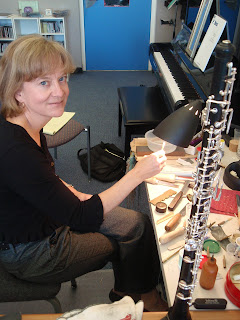People who play oboes, a double reed instrument, are often portrayed as finicky and tense.
The latter is because they make a lovely and strong sound by forcing a tremendous amount of air through a tiny opening in a reed. A lot of (literal) pressure is involved.
The former is because they have to make the thing they blow the air through. Well, not the whole instrument, but the reed.
“It’s something we have to do that doesn’t have anything to do with playing,” said Rebecca Nagel, principal oboist for the S.C. Philharmonic and a professor at USC.
Well, it has one thing to do with playing: if the reed isn’t right, the music won’t be either.
Nagel has settled between two basic reeds shapes, using one or the other depending on the music. For example Mozart needs to be lighter and brighter and Brahms big and lush. An oboe reed is usually good for a set of rehearsals and a concert.
Oboists, along with their double reed cousins the bassoon and English horn players, gather for Double Reed Day at USC Saturday. They’ll take part in workshops and master
classes. Some instruments and other implement of the trade will be on display at the music school and the day ends with a short, free concert that will include two new pieces written by student composers.
 One recent afternoon Nagel showed a visitor how to make a reed for an oboe, a soprano range instrument commonly constructed from African Blackwood. The oboe as we know it, with various changes, dates to 1650, but its ancestry can be traced back several centuries more to instruments from the Middle and Far East.
One recent afternoon Nagel showed a visitor how to make a reed for an oboe, a soprano range instrument commonly constructed from African Blackwood. The oboe as we know it, with various changes, dates to 1650, but its ancestry can be traced back several centuries more to instruments from the Middle and Far East.She starts with a hollow, 5-inch piece of cane about one-half an inch in diameter that comes from Arundo donax. Most cane used for instruments comes from southern France, but Nagel found a stand at Elmwood Cemetery in Columbia and it grows in warm areas around the world. She has drawers and drawers of short lengths of cane stored in plastic bags each labeled with information about where it came from and when. When a player finds a good batch, they buy as much as they can.
She starts by splitting the cane into three pieces with what looks like a steel stakes with barbs. Then she uses a set of machines (a guillotine and gougers) to roughly pare the pieces. One gouger has a satin silver surface and a dial micrometer to measure thickness, but the others are well-worn brass.
“Oh, you’ll like this,” Nagel says, pulling a book off a shelf. She opens it a page with engravings of reed making tools from the 1850s – they look just like the tools in her office.
Frequently sharpening tools, she achieves the basic shape then she folds the reed over on itself, clipping it to make two reeds.
Using nylon thread, a light aqua blue in this case, she attaches the reed to the staple or tube, the part that sticks into the body of the oboe. She gets this thread off a spool, but there’s a huge hank of multicolored threads hiding a c-clamp attached to her desk. Chairs in oboe players’ homes and offices tend to have thread tied to them.
“My parents still have strings on chairs,” said Nagel, who started playing the oboe in the fourth grade.
At this stage the reed looks, ready to blow. Nope. Nagel delicately shaves away bits of the reed. Some of it is done with reed-specific knives, some with a single-edge razor blade. The tip is shaved so thin it is translucent. She also fine tunes the central part, called the heart or plateau, and the back located just above the thread. When she’s done she has a lot of shredded reed in her lap.
Ready-made reeds can be purchased and students often buy reeds made by their teachers. Most oboe students don’t start making reeds until they’re well into high school and Nagel often spends as much time during a lesson on reed making as music making.
The process has taken about 15 minutes. She tests the reed, blowing or “crowing” which makes a vibrating sound. She does this a few times.
“This I would call hard and flat,” she says. “Ugly.”
She tosses it on the desk. She’ll never use it.
“It’s a lot of work and the outcome is uncertain,” she says. “Everyone thinks making reeds is cool until they have to do it.”
What to know about the oboe
Well-know works featuring the oboe have been written by composers from the
Baroque period onward including Vivaldi, Handel, Mozart, Poulenc, Benjamin Britten, Samuel Barber and Elliot Carter.
Orchestras tune to the oboe because it has a solid pitch and can be easily heard.
You can watch a fairly amusing time-lapse movie of reed making at http://www.youtube.com/watch?v=NhoCdKFcRaw&feature=related
This has to end with an oboe joke, which, not surprisingly, is actually about reed making.
How many oboists does it take to change a light bulb? Only one but they go through 50 bulbs to find the right one.

















No comments:
Post a Comment
Post comments under the anonymous listing if you do not subscribe to one of the services listed.